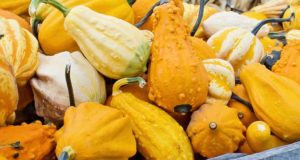Long before pressure canners or water-bath-canners existed, people preserved food by drying it. In fact, anthropologists have found dried corn and squash dating more than 6,000 years ago in ancient caves and dwellings.
 Home-canned foods do have a certain charm. Few things in life are as satisfying as a pantry lined with those familiar glass jars filled with bright fruits and vegetables. On the other hand, dehydrating foods has several benefits: Dehydrated foods lose fewer nutrients than canned foods. The risk of serious food poisoning, such as botulism, is all but nil in dried foods. Dehydrating foods takes less time, energy, and money than canning, and dried foods are lightweight and compact, making them a great choice for survivalists.
Home-canned foods do have a certain charm. Few things in life are as satisfying as a pantry lined with those familiar glass jars filled with bright fruits and vegetables. On the other hand, dehydrating foods has several benefits: Dehydrated foods lose fewer nutrients than canned foods. The risk of serious food poisoning, such as botulism, is all but nil in dried foods. Dehydrating foods takes less time, energy, and money than canning, and dried foods are lightweight and compact, making them a great choice for survivalists.
Although you can dry foods simply by leaving them in a dry place for a few days, you’ll have a much tastier and nutritious product if you follow a few simple prep rules. Read on to learn everything you need to know to dehydrate delicious foods at home.
Selecting Produce For Dehydration
The final product is only as good as the produce you begin with, so use only the freshest fruits and vegetables you can find. Produce should be fully ripe. Under-ripe produce yields little flavor, while produce that is too ripe has excess moisture and may decay.
Garden produce is probably your first choice for dehydration, but you can also use produce purchased at the grocery store or a farmer’s market. If you see a great price on fruit, stock up. Freeze some, can some, and dehydrate some so you have a variety of food options. This is an excellent choice for dried foods that are very expensive to purchase. For example, our family loves dried blueberries and cherries, but they’re usually costly to buy. I watch for rock-bottom sales in early to mid-summer and dry them myself. I save a bundle, and I ensure that they’re not treated with sulfur, which is an allergen to many people.
Wash all fruits and vegetables thoroughly and remove pits and seeds. Whether to peel fruits is usually a matter of personal preference, although the peels do contain nutrients. Cut produce into small, uniform pieces—usually ¾ inch or smaller.
Preparing Vegetables
To prepare vegetables for dehydration, steam blanch them first to halt the ripening process. Fill a large pot with two to three inches of water and heat to boiling. Fill a steamer insert or colander with the produce and put it over the boiling water. Steam for three to five minutes, adding one to two extra minutes if you live 5,000 feet or more above sea level. Drain the vegetables and chill in ice water. Drain and dry on towels.
Learn The Most Affordable Ways To Can All Different Kinds Of Vegetables And Meats…
Preparing Fruit
When preparing fruit, your main concern is preserving color and flavor. Steam blanch apples, pears, apricots, and bananas as detailed above. Dip berries, cherries, and peaches in ascorbic acid or make a honey dip. To make the dip, combine three cups water with one cup of sugar. Heat to boiling to dissolve the sugar. Stir in one cup of honey and cool. Dip the fruit in for thirty seconds and drain on towels.
Dehydration Methods
The simplest method, of course, is air-drying, which is how early colonists and pioneers preserved food. This method works best if you live in a warm, dry climate. String peas, green beans, mushrooms, carrots, or onions on a length of cotton string with a needle. Hang the string in a dry, ventilated area, out of direct sunlight. Try under the attic eaves or on an airy front porch. Check the produce daily. Depending on conditions and the type of vegetable, the process usually takes three to four days. When finished, place the vegetables on a cookie sheet and bake at 175 degrees Fahrenheit for thirty minutes to kill any insect eggs or pathogens.
To sun dry foods safely, you must live in a dry area. The ideal temperature is around 100 degrees Fahrenheit with humidity levels below 50 percent. To sun dry food, stretch a piece of cheesecloth securely over a cookie sheet or old frame. Lay the food on the cheesecloth so air circulates freely. Cover the tray with another sheet of cheesecloth to keep out bugs. Set the trays in direct sunlight, but bring the trays in at night so they don’t get moisture on them. Within a day or two, you’ll have dried fruits and vegetables.
Oven drying is very easy, but it takes more energy and heats up your house. To dry produce in the oven, simply place the produce on cookie sheets, or better yet, cooling racks. Place the racks in the oven and set the oven at its lowest temperature—usually between 120 and 170 degrees. Leave the oven door slightly ajar so moisture can escape. Cook the food for three to twelve hours, checking it frequently. It should feel dry, but still slightly pliable.
Finally, if you hope to dehydrate a lot of food, you’ll probably want to invest in a food dehydrator. Dehydrators have multiple trays for storing food. Most even have settings so you can control the temperature and drying times.
Regardless of the dehydration method you choose, once you’ve dehydrated the food, pour it into a large plastic bowl and place it on the kitchen counter for a week or so. This allows any lingering moisture to dissipate and improves flavor and texture. Stir the dehydrated food occasionally. Then, pasteurize it to kill any bacteria. Place it in a 175 degree oven for ten minutes or pack it in bags and freeze it at 0 degrees Fahrenheit for up to one week. Finally, pack the dried foods in glass containers or resealable plastic bags. Label the packages and store them in a cool, dry, dark location for up to one year.
Using Dehydrated Foods
You can certainly eat many dried fruits and vegetables out of hand without rehydrating them. Top oatmeal or granola with dried apples, blueberries, or raspberries. Add dried bananas or peaches to trail mixes or munch on dried tomatoes for a flavorful snack.
If you hope to cook with dried foods, though, it’s best to rehydrate them first. Place dried beans, carrots, peas or onions in a bowl and pour boiling water over them. Let them stand for several hours until most of the water is absorbed before adding them to a recipe. Use the water you rehydrated the vegetables in for cooking since it contains a lot of nutrients and flavor. Read on to learn some specific ideas for using dried fruits and vegetables:
- Rehydrate dried apples or peaches in juice. Drain and use as you would fresh fruit in pies, crisps, and cobblers.
- Combine dried carrots, onions, peas, and herbs with a variety of dried beans and rice for a tasty soup mix.
- Pulverize dried foods in a blender to make powders. Combine the powders with water to make baby food or add them to spaghetti sauce, soups, and even smoothies to hide extra nutrition.
©2012 Off the Grid News
 Off The Grid News Better Ideas For Off The Grid Living
Off The Grid News Better Ideas For Off The Grid Living




